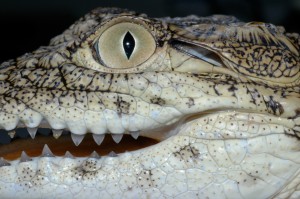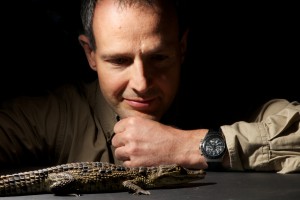 The ancestral crocodylian evolved multiple, multisensory micro-organs located on their skin which can detect chemical, thermal, and mechanical changes in their environment finds new research published in EvoDevo today. This helps to explain how crocodylians were able to evolve their highly armoured skin whilst retaining sensory capabilities required for survival in the numerous environments in which they live.
The ancestral crocodylian evolved multiple, multisensory micro-organs located on their skin which can detect chemical, thermal, and mechanical changes in their environment finds new research published in EvoDevo today. This helps to explain how crocodylians were able to evolve their highly armoured skin whilst retaining sensory capabilities required for survival in the numerous environments in which they live.
Armoured plating provides protection but usually also carries the drawback of reduced sensory capabilities- which can be a problem if you hunt prey in murky water. However, as researchers from the University of Geneva have discovered, crocodylians (which include true crocodiles, gharials, alligators and caiman) have an ingenious and unique solution to this problem. They have evolved multi-sensory organs, called Integumentary Sensory Organs (ISOs) which contain multiple pools of sensory neurons. ISOs are also known as Dome Pressure Receptors, as they were previously only thought to respond to  changes in pressure.
changes in pressure.
ISOs were compared in two species of crocodylian with differing distributions of these organs on their bodies; the Nile Crocodile (Crocodylus niloticus) which has cranial and post-cranial ISOs, and the Spectacled Caiman (Caiman crocodilus), which has only cranial ISOs. Researchers conducted several experiments designed to examine structure, innervation, embryonic morphogenesis and sensory function of these organs.
Prof Michel Milinkovitch, who led this study explained, “ISO sensors are remarkable because not only are they able to detect many different types of physical and chemical stimuli, but because there is no equivalent in any other vertebrates. It is this transformation of a diffuse sensory system, such as we have in our own skin, into ISO which has allowed crocodilians to evolve a highly armoured yet very sensitive skin.”
The similarity in morphology and development during embryogenesis indicates a common evolutionary origin of these organs, which are unique amongst vertebrates, across all crocodylians. These structures must provide wide benefits to crocodylians- so perhaps that’s why crocodiles, along with birds, are the only remaining survivors of the dinosaur lineage.
Images provided by Michel Milinkovitch
Latest posts by Rhiannon Meaden (see all)
- Guinea pig teenagers are highly domesticated - 9th April 2014
- Goats, the boffins of the farmyard - 26th March 2014
- Developments in Daphnia - 25th March 2014

Comments